Flensburg
Flensburg (German: [ˈflɛnsbʊʁk] ⓘ; Danish and Low Saxon: Flensborg; South Jutlandic: Flensborre; North Frisian: Flansborj) is an independent town in the north of the German state of Schleswig-Holstein. Flensburg is the north of the region of Schleswig. After Kiel and Lübeck, it is the third-largest town in Schleswig-Holstein.
Flensburg
| |
|---|---|
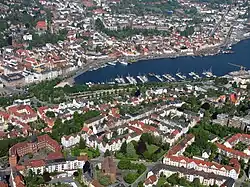 Flensburg Harbour in 2012 | |
 Flag 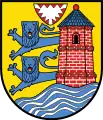 Coat of arms | |
Location of Flensburg | |
 Flensburg 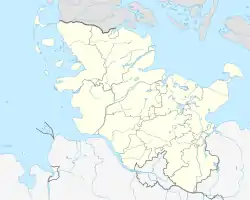 Flensburg | |
| Coordinates: 54°46′55″N 09°26′12″E | |
| Country | Germany |
| State | Schleswig-Holstein |
| District | Urban district |
| Subdivisions | 13 Stadtbezirke |
| Government | |
| • Lord mayor | Fabian Geyer (Ind.) |
| Area | |
| • Total | 56.38 km2 (21.77 sq mi) |
| Elevation | 12 m (39 ft) |
| Population (2021-12-31)[1] | |
| • Total | 91,113 |
| • Density | 1,600/km2 (4,200/sq mi) |
| Time zone | UTC+01:00 (CET) |
| • Summer (DST) | UTC+02:00 (CEST) |
| Postal codes | 24901–24944 |
| Dialling codes | 0461 |
| Vehicle registration | FL |
| Website | www.flensburg.de |
Flensburg's city centre lies about 7 km (4 mi) from the Danish border.
Known for
In Germany, Flensburg is known for:
- the Kraftfahrt-Bundesamt (roughly: National Driver and Vehicle Register) with its Verkehrssünderkartei (literally: "traffic sinner card file"), where details of traffic offences are stored[2]
- its beer Flensburger Pilsener, also called "Flens"
- the centre of the Danish national minority in Germany
- the greeting Moin
- the large erotic mail-order companies Beate Uhse and Orion
- its handball team, SG Flensburg-Handewitt
- the Naval Academy at Mürwik
- being the final seat of the Third Reich from 1 May 1945, following Adolf Hitler's death, until the Third Reich's final, formal dissolution in early June 1945.
Geography
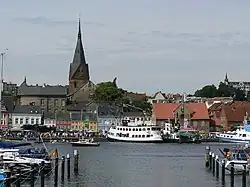
Flensburg is in the north of the German state Schleswig-Holstein, very close to the German-Danish border. After Westerland, on the island of Sylt, it is Germany's northernmost town. Flensburg lies at the innermost tip of the Flensburg Firth, an inlet of the Baltic Sea. Flensburg's eastern shore is part of the Anglia peninsula.
Neighbouring municipalities
Clockwise from the northeast, beginning at the German shore of the Flensburg Firth, the following communities in Schleswig-Flensburg district and Denmark's Southern Denmark Region all border Flensburg:
Glücksburg (Amt-free town), Wees (Amt Langballig), Maasbüll, Hürup, Tastrup and Freienwill (all in Amt Hürup), Jarplund-Weding, Handewitt (Amt Handewitt), Harrislee (Amt-free community) and Aabenraa Municipality on the Danish shore of the Flensburg Firth.
Constituent communities
The town of Flensburg is divided into 13 communities, which are further divided into 38 statistical areas. Constituent communities have a two-digit number and the statistical areas a three-digit number.

The communities with their statistical areas:
- 01 Altstadt (Old Town) Lies somewhat down towards the sea rather than right downtown.
- 011 St. Nikolai (Danish: Skt. Nikolaj)
- 012 St. Marien
- 013 Nordertor (Danish: Nørreport)
- 02 Neustadt (Danish: Nystaden)
- 021 Duburg (Danish: Duborg)
- 022 Neustadt Nord
- 03 Nordstadt (Danish: Nordstaden)
- 031 Kreuz (Danish: Kors)
- 032 Galwik (Danish: Galvig)
- 033 Klues (Danish: Klus)
- 04 Westliche Höhe
- 041 Stadtpark (Danish: Byparken)
- 042 Marienhölzung (Danish: Frueskov)
- 043 St. Gertrud
- 044 Friedhof
- 05 Friesischer Berg (Danish: Friserbjerg)
- 051 Exe (Danish: Exe or Eksercerløkke)
- 052 Museumsberg
- 053 Friedenshügel (Danish: Fredshøj)
- 06 Weiche (Danish: Sporskifte)
- 061 Sophienhof (Danish: Sophiegård)
- 062 Schäferhaus (Danish: Skæferhus)
- 07 Südstadt
- 071 Martinsberg (Danish: Martinsbjerg)
- 072 Rude (Danish: Ryde)
- 073 Peelwatt (Danish: Pælevad)
- 08 Sandberg (Danish: Sandbjerg)
- 081 Achter de Möhl (Danish: Fiskergaarden)
- 082 Adelbylund
- 083 Sünderup (Danish: Synderup)
- 09 Jürgensby (Danish: Jørgensby)
- 091 St. Johannis (Danish: Sankt Hans)
- 092 St. Jürgen (Danish: Sankt Jørgen)
- 093 Jürgensgaard (Danish: Jørgensgaard)
- 094 Sender Flensburg-Jürgensby
- 10 Fruerlund
- 101 Blasberg (Danish: Blæsbjerg)
- 102 Bohlberg (Danish: Bolsbjerg)
- 103 Fruerlund Hof
- 11 Mürwik (Danish: Mørvig)
- 111 Stützpunkt
- 112 Osbek (Danish: Osbæk)
- 113 Wasserloos (Danish: Vandløs)
- 114 Friedheim
- 115 Solitüde (Danish: Solitude)
- 12 Engelsby
- 121 Engelsby Süd
- 122 Vogelsang (Danish: Fuglsang)
- 13 Tarup
- 130 Tarup
History
Middle Ages
.JPG.webp)
.JPG.webp)
Flensburg was founded at the latest by 1200 at the innermost end of the Flensburg Firth by Danish settlers, who were soon joined by German merchants. In 1284, its town rights were confirmed and the town quickly became one of the most important in the Duchy of Schleswig. Unlike Holstein, Schleswig did not belong to the German Holy Roman Empire. Therefore, Flensburg was not a member of the Hanseatic League, but did maintain contacts with it.
Historians presume that there were several reasons this spot was chosen for settlement:
- Shelter from heavy winds
- A trade route between Holstein and North Jutland (namely the Hærvejen or Ochsenweg, a series of roads between Hamburg, Schleswig-Holstein and Jutland, possibly dating from the Bronze Age)
- The Angelnway: a trade route between North Frisia and Angeln
- A good herring fishery
Herrings, especially kippered, brought about the blossoming of the town's trade in the Middle Ages. They were sent inland and to almost every European country.
On 28 October 1412, Queen Margaret I of Denmark died of the plague aboard a ship in Flensburg Harbour.
From time to time plagues such as bubonic plague, caused mainly by rat fleas (Xenopsylla cheopis, a parasite found on brown rats), "red" dysentery and other scourges killed much of Flensburg's population. Lepers were strictly isolated at the St.-Jürgen-Hospital (Helligåndshospital, built before 1290), far outside the town's gates, where St. Jürgen Church is now. About 1500, syphilis also appeared. The church hospital "Zum Heiligen Geist" ("To the Holy Ghost") stood in Große Straße, now Flensburg's pedestrian precinct.
A Flensburger's everyday life was very hard, and the old roads and paths were bad. The main streets were neither paved nor lit at night. When the streets became really bad, citizens made the dung-filled streets passable with wooden pathways. Only the few upper-class houses had windows. In 1485, a great fire struck Flensburg. Storm tides also beset the town occasionally. Every household in the town kept livestock in the house and the yard. Townsfolk furthermore had their own cowherds and a swineherd.
Early modern times
After the fall of the Hanseatic League in the 16th century, Flensburg was said to be one of the most important trading towns in the Scandinavian area. Flensburg merchants were active as far away as the Mediterranean, Greenland, and the Caribbean. The most important commodities, after herring, were sugar and whale oil, the latter from whaling off Greenland. But the Thirty Years' War put an end to this boom time. The town was becoming Protestant and thereby ever more German culturally and linguistically, while the neighbouring countryside remained decidedly Danish.
In the 18th century, thanks to the rum trade, Flensburg had yet another boom. Cane sugar was imported from the Danish West Indies (now the US Virgin Islands) and refined in Flensburg. Only in the 19th century, as a result of industrialization, was the town at last outstripped by the competition from cities such as Copenhagen and Hamburg.
The rum produced in Flensburg was then reintegrated into West Indian trade routes, which as of 1864 moved away from the Danish West Indies to the British colony of Jamaica instead. It was imported from there, blended, and sold all over Europe. There is now only one active rum distillery in Flensburg, "A. H. Johannsen".

History as a German town
Between 1460 and 1864, Flensburg was, after Copenhagen, the Kingdom of Denmark's second-biggest port, but it passed to the Kingdom of Prussia after the Second Schleswig War in 1864. The Battle of Flensburg was on February 6, 1864: near the city a small Hungarian mounted regiment chased a Danish infantry and Dragoon regiment. A sizable Danish community remains in the town. Some estimates put the percentage of Flensburgers who belong to it as high as 25%; other estimates put it much lower. The SSW political party representing the minority usually gains 20–25% of the votes in local elections, but not all its voters are Danes. Before 1864, more than 50% belonged to what is now the minority; even today there are many Danish surnames in the Flensburg telephone directory (Asmussen, Claussen, Jacobsen, Jensen, Petersen, etc.). But the upper classes and the learned at that time were German, and since 1864, the German language has prevailed in the town.
On 1 April 1889, Flensburg became an independent city (kreisfreie Stadt) within the Province of Schleswig-Holstein, and at the same time still kept its status as seat of the Flensburg district. In 1920, the League of Nations decided that the matter of the German–Danish border would be settled by a vote. As a result of the plebiscite, and the way the voting zones were laid out, some of Flensburg's northern neighbourhoods were ceded to Denmark, whereas Flensburg as a whole voted by a large margin to stay in Germany.
In return for this pro-German vote, Flensburg was given a large hall, the "Deutsches Haus", which the government endowed as "thanks for German loyalty".
During the Second World War, the town was left almost unscathed by the air raids that devastated other German cities. But in 1943, 20 children died when a nursery school was bombed, and shortly after the war ended, an explosion at a local munitions storage site claimed many victims.
%252C_Bild_002.JPG.webp)
In 1945, Admiral Karl Dönitz, who was briefly President (Reichspräsident) of Nazi Germany after Adolf Hitler appointed him his successor and then killed himself, fled to Flensburg with what was left of his government. The so-called Flensburg Government, led by Dönitz, was in power from 1 May, the announcement of Hitler's death, for one week, until German troops surrendered and the town was occupied by Allied troops. The regime was effectively dissolved on 23 May, when the British Army arrested Dönitz and his ministers in Mürwik and detained them in the Navy School in Mürwik (German: Marineschule Mürwik). The Berlin Declaration promulgated on 5 June formalized the dissolution. Flensburg was therefore, for a few weeks, the seat of the last Third Reich government.
Since the Second World War
After the Second World War, the town's population broke the 100,000 mark for a short time, making Flensburg a city (Großstadt) under one traditional definition. The population later sank below that mark.
In 1945, after the suicide of Joseph Goebbels, the Dönitz Cabinet moved to Flensburg as Berlin was under assault by the Soviets and since Denmark and areas around Kiel were still under firm German hands.
In the years after the Second World War, South Schleswig, and particularly Flensburg, had a strong pro-Danish movement connected with the idea of the "Eider Politics". Its goal was for the town and all or most of Schleswig, the whole area north of the Eider River, to be united with Denmark. After 1945, Flensburg's town council was for years dominated by Danish parties, and the town had a Danish mayor.
The town profited from the planned location of military installations. Since German Reunification, the number of soldiers has dropped to about 8,000. Since Denmark's entry into the European Economic Community (now the European Union), border trade has played an important role in Flensburg's economic life. Some Danish businesses, such as Danfoss, have set up shop just south of the border for tax reasons.
In 1970, the Flensburg district was expanded to include the municipalities in the Amt of Medelby, formerly in the Südtondern district, and in 1974 it was united with the Schleswig district to form the district of Schleswig-Flensburg, whose district seat was the town of Schleswig. Flensburg thereby lost its function as a district seat but remained an independent (district-free) town.
Amalgamations
Until the middle of the 19th century, Flensburg's municipal area comprised an area of 2 639 ha. Beginning in 1874, the following communities or rural areas (Gemarkungen) were annexed to the town of Flensburg:
| Year | Place(s) | Area added in ha |
|---|---|---|
| 1874 | Süder- and Norder-St. Jürgen | 36 |
| 1874 | Fischerhof | 3 |
| 27 July 1875 | Duburg | 10.5 |
| 1877 | Hohlwege and Bredeberg | 5.5 |
| 1 December 1900 | Jürgensgaarde | 205 |
| 1 April 1909 | Klues | 19 |
| 1 April 1910 | Twedt, Twedterholz/Fruerlund and Engelsby | 1458 |
| 1916 | part of Klues Forest (incl. open waters) | 146.5 |
| 26 April 1970 | Adelbylund | 132 |
| 10 February 1971 | demerger of Wassersleben Beach | -147.5 |
| 22 March 1974 | Sünderup and Tarup | ? |
Population development
Population figures are for respective municipal areas through time. Until 1870, figures are mostly estimates, and thereafter census results (¹) or official projections from either statistical offices or the town administration itself.
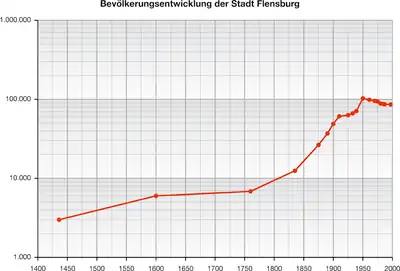 |
| Year | Population figure |
|---|---|
| 1436 | 3000 |
| 1600 | 6000 |
| 1760 | 6842 |
| 1835 | 12,483 |
| 1 December 1875 ¹ | 26,474 |
| 1 December 1890 ¹ | 36,894 |
| 1 December 1900 ¹ | 48,937 |
| 1 December 1910 ¹ | 60,922 |
| 16 June 1925 ¹ | 63,139 |
| 16 June 1933 ¹ | 66,580 |
| 17 May 1939 ¹ | 70,871 |
| 13 September 1950 ¹ | 102,832 |
| 6 June 1961 ¹ | 98,464 |
| 27 May 1970 ¹ | 95,400 |
| 30 June 1975 | 93,900 |
| 30 June 1980 | 88,200 |
| 30 June 1985 | 86,900 |
| 27 May 1987 ¹ | 86,554 |
| 30 June 1997 | 86,100 |
| 31 December 2003 | 85,300 |
| 31 December 2012 | 89,375 |
¹ Census results
Danish minority

The Danish minority in Flensburg and the surrounding towns runs its own schools, libraries, and Lutheran churches, from which the German majority is not excluded. These two groups' coexistence is considered a sound and healthy symbiosis. A form of mixed Danish–German, Petuh, is used on the ferries.
There is also a Danish Consulate-General in Flensburg.[3]
In Denmark, Flensburg seems to be mainly known for its "border shops" where, among other things, spirits, beer and candy are for sale at lower prices than in Denmark. The prices are lower because the value-added tax is lower and excise taxes are either lower (e.g., on alcohol) or do not exist (e.g., on sugar). The border shops may sell canned beer to Scandinavia residents without paying deposits as long as it is not consumed in Germany.
| Significant minority groups | |
| Nationality | Population (31.12.2022) |
| 3,095 | |
| 2,930 | |
| 2,455 | |
| 1,285 | |
| 1,120 | |
Politics
For centuries, two mayors led the town council, one for the north town (St. Marien) and one for the south town (St. Nikolai and St. Johannis). The council members and mayors were chosen by the council itself: retiring officials' successors were named by the remaining councillors in such a way that both halves of the town had as many members. These councillors usually bore the title "Senator".
This "town government" lasted until 1742 when the "northern mayor" was made the "directing mayor" by the Danish King. From this position came what was later known as the First Mayor. The second mayor simply bore the title "mayor" ("Bürgermeister"). After the town was ceded to Prussia, the townsfolk elected the mayors as of 1870, and the First Mayor was given the title Oberbürgermeister, still the usual title in German towns and cities. During the Third Reich, the town head was appointed by those who held power locally.
In 1945, after the Second World War, a twofold leadership based on a British model was introduced. Heading the town stood foremost the Oberbürgermeister, who was chosen by the town council and whose job was as chairman of council and the municipality. Next to him was an Oberstadtdirektor ("Higher Town Director"), who was leader of administration. In 1950, when Schleswig-Holstein brought its new laws for municipalities into force, the title Oberbürgermeister was transferred (once again) to this latter official. At first, and for a while, he was chosen by the council. Since that time, the former official has been called the Stadtpräsident ("Town President"), and is likewise chosen by the council after each municipal election. Since 1999, the Oberbürgermeister has been chosen directly by the voters, as before.
The first directly elected Oberbürgermeister, Hermann Stell, died on 4 May 2004 of a stroke. On 14 November 2004, the independent candidate suggested by the CDU, Klaus Tscheuschner, was elected to replace Stell with 59% of the vote. In the 2003 municipal election, Hans Hermann Laturnus was elected Stadtpräsident.
In the 2008 municipal election, the local list WiF (Wir in Flensburg) was elected the largest group in the Council Assembly of Flensburg, with 10 city councillors out of 43, closely followed by the South Schleswig Voter Federation (Südschleswigscher Wählerverband) (9 councillors) and the CDU (9 councillors). Also elected was the SPD (seven councillors), the Greens (3 councillors), the Left (3 councillors) and the FDP (2 councillors).[4] Nevertheless, since the WiF-group was divided into two different caucuses, the SSW-group has been the assembly's largest group.[5] The City President is Christian Dewanger (WiF).[6]
In the 2010 mayoral election, Simon Faber (SSW) was elected Lord Mayor of the town in a runoff election with 54.8% of the vote. He was the first person from the Danish Minority to occupy this office since the end of World War II.[7]
Mayor
The mayor of Flensburg is Fabian Geyer,[8] who was elected in 2022. He took office on 15 January 2023.
City council


The Flensburg city council governs the city alongside the mayor. The most recent city council election was held on 14 May 2023, and the results were as follows:
| Party | Votes | % | +/- | Seats | +/- | |
|---|---|---|---|---|---|---|
| South Schleswig Voters' Association (SSW) | 6,785 | 24.8 | 11 | |||
| Alliance 90/The Greens (Grüne) | 6,470 | 23.6 | 10 | |||
| Christian Democratic Union (CDU) | 5,248 | 19.1 | 8 | ±0 | ||
| Social Democratic Party (SPD) | 3,703 | 13.5 | 6 | |||
| Free Democratic Party (FDP) | 1,553 | 5.7 | 2 | |||
| The Left (Die Linke) | 1,133 | 4.1 | 2 | |||
| We in Flensburg (WiF) | 670 | 2.4 | 1 | |||
| Solidarity City Alliance (BüsoS) | 571 | 2.1 | 1 | |||
| Grassroots Democratic Party of Germany (dieBasis) | 525 | 1.9 | 1 | |||
| Flensburg Votes! (FLW) | 429 | 1.5 | 1 | ±0 | ||
| Volt Germany (Volt) | 328 | 1.2 | 1 | |||
| Valid votes | 27,406 | 99.2 | ||||
| Invalid votes | 219 | 0.8 | ||||
| Total | 27,625 | 100.0 | 44 | |||
| Electorate/voter turnout | 77,296 | 35.7 | ||||
| Source: City of Flensburg | ||||||
The result of the election held 6 May 2018 were as follows:
| Party | Votes | % | +/- | Seats | +/- | |
|---|---|---|---|---|---|---|
| Christian Democratic Union (CDU) | 5,233 | 19.4 | 8 | |||
| Alliance 90/The Greens (Grüne) | 5,088 | 18.8 | 8 | |||
| Social Democratic Party (SPD) | 4,930 | 18.2 | 8 | |||
| South Schleswig Voters' Association (SSW) | 4,756 | 17.6 | 8 | ±0 | ||
| We in Flensburg (WiF) | 2,320 | 8.6 | 4 | |||
| Free Democratic Party (FDP) | 2,087 | 7.7 | 3 | |||
| The Left (Die Linke) | 2,021 | 7.5 | 3 | |||
| Flensburg Votes! (FLW) | 599 | 2.2 | 1 | ±0 | ||
| Valid votes | 27,034 | 98.9 | ||||
| Invalid votes | 288 | 1.1 | ||||
| Total | 27,322 | 100.0 | 43 | ±0 | ||
| Electorate/voter turnout | 76,827 | 35.6 | ||||
| Source: City of Flensburg | ||||||
Coat of arms
Flensburg's coat of arms shows in gold above blue and silver waves rising to the left a six-sided red tower with a blue pointed roof, breaking out of which, one above the other, are the two lions of Schleswig and Denmark; above is a red shield with the silver Holsatian nettle leaf on it. The town's flag is blue, overlaid with the coat of arms in colour.
The lions symbolize Schleswig, and the nettle leaf Holstein, thus expressing the town's unity with these two historic lands. The tower recalls Flensburg's old town rights and the old castle that was the town's namesake (Burg means "castle"). The waves refer to the town's position on the Flensburg Fjord.
The coat of arms was granted the town by King Wilhelm II of Prussia in 1901, and once again in modified, newly approved form on 19 January 1937 by Schleswig-Holstein's High President (Oberpräsident)
Twin towns – sister cities
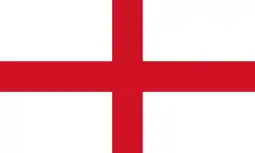 Carlisle, England, United Kingdom
Carlisle, England, United Kingdom Neubrandenburg, Germany
Neubrandenburg, Germany Słupsk, Poland
Słupsk, Poland
Economy and infrastructure
Energy
The town has a well-established Combined Heat and Power and District Heating scheme, installed between 1970 and 1980.[10] It is owned by the town.
Transport
West of Flensburg runs the A 7 Autobahn, leading north to the Danish border, whence it continues as European route E45. Federal Highways (Bundesstraßen) B 200 and B 199 also pass through the municipal area.
West of the town lies the Flensburg-Schäferhaus airport.
Local transport is provided by several buslines, including Aktiv Bus GmbH and Allgemeinen Flensburger Autobus Gesellschaft (AFAG). They all operate on an integrated fare system within the Flensburg transport community (Verkehrsgemeinschaft Flensburg). They also all subscribe to the Schleswig-Holstein tariff system, whereby anyone travelling from anywhere in Schleswig-Holstein or Hamburg may use Flensburg buses free to connect with their final destinations. This works both ways: a rider boarding any bus in Flensburg need only name a destination anywhere in Schleswig-Holstein or Hamburg, pay the fare, and travel to that destination on one ticket.
The Flensburg station opened in 1927 south of the Old Town. From there, trains run on the main line to Neumünster, Hamburg, and Fredericia, among them some InterCity connections as well as trains serving the line running to Eckernförde and Kiel. Another stop for regional trains to Neumünster is in Flensburg-Weiche. The stretch of line to Niebüll has been out of service since 1981, efforts to open it again notwithstanding. The secondary line to Husum and lesser lines to Kappeln and Satrup no longer exist. The tramway, which opened in 1881 to horse-drawn trams, was electrified in 1906, and at one point ran four lines, was replaced by buses in 1973.
Media
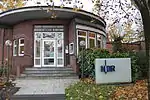
In Flensburg, the Flensburger Tageblatt, from the Schleswig-Holsteinischer Zeitungsverlag (newspaper publisher) is published daily, as is the bilingual (German and Danish) Flensborg Avis. There are also two weekly advertising flyers, MoinMoin (named for a common regional greeting) and Wochenschau (Newsweek) as well as an illustrated town paper (Flensburg Journal), the Flensburg "campus newspaper" and a town magazine (Partout). Norddeutscher Rundfunk (NDR) runs one of its oldest studios near the Deutsches Haus. Flensburg is the site of a number of radio transmission facilities: on the Fuchsberg in the community of Engelsby, Norddeutscher Rundfunk runs a transmission facility for VHF, television and medium wave. A cage aerial is mounted on a 215-metre-high (705 ft) guyed, earthed steel-lattice mast. This transmitter is successor to the Flensburg transmitter through which Germany's surrender was announced on 8 May 1945.
The broadcasting tower on the Fuchsberg is used for the programmes of Norddeutscher Rundfunk and Danmarks Radio while the countrywide VHF radio programmes of R.SH, delta radio, Deutschlandfunk and Deutschlandradio air from the Flensburg-Freienwill tower.
Flensburg has no local transmitter of its own because Schleswig-Holstein's state broadcasting laws allow only transmitters that broadcast statewide. From 1993 to 1996, "Radio Flensburg" tried to establish a local Flensburg radio station by using a local transmitter just across the border in Denmark, but it had to be shut down, owing to the Danish transmitter's own financial problems. Since October 2006, Radio Flensburg has broadcast as internet radio.
The "Offener Kanal" ("Open Channel") shows programmes made by local citizens seven days a week, mostly in the evenings, and can also be seen on cable television.
Public institutions
Flensburg is home to the following institutions:
- Handwerkskammer Flensburg (Chamber of Skilled Crafts)
- IHK Flensburg (Chamber of Trade and Industry)
- Kraftfahrt-Bundesamt (federal government office for road traffic)
Education
- University of Flensburg has about 6,000 students as of 2019/20. Founded in 1946 as a pedagogical college, it became a university in 1994. Unlike the much larger University of Kiel it is not a full university; theology, medicine, law and some other programs are not offered here. But it does have the right to confer doctorates.
- Fachhochschule Flensburg is a Fachhochschule with more than 3,000 students; in 1886 a royal steamship machinist school was established, out of which developed a ship's engineers' school. From this grew the Fachhochschule for Technology, which was converted into the Fachhochschule Flensburg in 1973, at which time the economics programme was introduced.
- Marineschule Mürwik (Naval Academy at Mürwik), the main educational establishment for all German Navy officers.
- Flensburger Volkshochschule (German Folk high school)
- Voksenundervisningen (Danish)
Also in Flensburg is a complete range of training and professional schools, including a number of Danish ones. Flensburg is home to Schleswig-Holstein's Central State Library, a university library, a town bookshop and the Danish Central Library for South Schleswig, which offers not only intensive courses in Danish, but also, with its "Slesvigsk samling" collection, a vast repository of unique material about the border area's history and culture. Flensburg has an extensive town archive. The Danish minority's archive is housed at the Danish Central Library.
Culture and sightseeing
.JPG.webp)
.jpg.webp)
Theatre
- Schleswig-Holsteinisches Landestheater (at the Stadttheater) and Symphony Orchestra
- Niederdeutsche Bühne der Stadt Flensburg (Low German Stage of the city of Flensburg)
- Det Lille Teater (Danish theatre)
- Theaterwerkstatt Pilkentafel (Theatre Workshop)
- Orpheus-Theater
Archives and libraries
- Town Archive, a very comprehensive collection, at the town hall
- Dansk Centralbibliotek for Sydslesvig, with archive of the Danish minority and Schleswig book collection
- Town Library
- State Central Library and Zentrale Hochschulbibliothek (Central College Library)
Museums
- Museumsberg – Museum for artistic and cultural history
- Schifffahrtsmuseum – Museum for shipping and shipbuilding
- Rummuseum – History of the "Rum Town" of Flensburg.
- Naturwissenschaftliches Museum – Animal and plant worlds of northern Schleswig-Holstein
- Museumshafen – Private initiative for maintaining old traditional working boats mainly from the Baltics (Segelschiffe)
- Museumswerft – Shipbuilding (sail) of bygone centuries. The place also has a children's boatyard.
- Fischereimuseum – Initiative of the fishery association, lies on the old fishery harbour
- Phänomenta – For experiencing and understanding nature and technology
- Salondampfer "Alexandra" – passenger steamer built 1908. The Alexandra regularly makes small trips in the Flensburg Förde (bay)
- Klassische Yachten Flensburg – classic yacht harbour. Private initiative to present classic yachts typical of the Baltics.
- Gerichtshistorische Sammlung – a collection of legal history at the Flensburg State Court
- Bergmühle – Association for maintaining the historic windmill from 1792
- Johannesburger Heimatstube – Documents, pictures and writings from East Prussia
Buildings
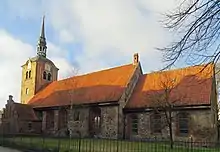


Flensburg has a well-preserved Old Town with many things to see from centuries past. Characteristic is the row along the waterfront. Three of the four old town cores are along this north–south axis. The building boom in imperial times led to a partial rebuilding of the Old Town, but without destroying its structure, and leading to notable expansion of the town. Virtually unscathed in the Second World War, Flensburg, like other places in Germany, adopted a policy of getting rid of old buildings and rebuilding in the style of the time. Lack of money limited this trend in Flensburg, but before the policy ended in the late 1970s, countless old buildings had been demolished in the north and east Old Town, to be replaced by newer structures. Despite great losses, Flensburg still has a compact, well-preserved Old Town in the valley with good additions to what was built in the founders' time on the surrounding heights.
- Johanniskirche (Flensburg) Johanniskirche (Johannischurch), town's oldest church in the innertown, 12th century
- Marienkirche (Flensburg) Marienkirche, High Gothic, Baroque additions, tower from 1885, well decorated
- Nikolaikirche (Flensburg) Nikolaikirche, Gothic main church, famous organ design by Hinrich Ringeringk
- Heiliggeistkirche (Flensburg) Heiliggeistkirche (Danish: Helligåndskirken), former chapel of the Hospital zum Heiligen Geist
- Franziskanerkloster Flensburg Franziskanerkloster, ruins from 1263
- Nordertor, a gate, and the town's landmark
- Kompagnietor another gate, built in 1602, shipping company and harbour gate
- Alt-Flensburger Haus, where the Eckener brothers' parents lived, Norderstraße 8
- Flensborghus, a former orphanage, today seat of the Danish minority, Norderstraße 76
- Many merchants' houses running from the main streets Holm-Große Straße-Norderstraße, the town's greatest architectural attraction
- Südermarkt 9 (market) with the town's oldest house
- Nordermarkt (market) with the Schrangen (market hall) and Neptunbrunnen (fountain)
- Rote Straße with nice craftsmen's houses
- Jürgenstraße with the Gängeviertel ("Warren Neighbourhood", i.e. with very dense building and narrow streets), former suburb.
- Oluf-Samson-Gang, picturesque lane with little half-timbered houses, Flensburg's historic red light district.
- Row of warehouses
- Ship bridge (Schiffbrücke), a long quay on the harbour
- Scanty ruins of the town wall, at the Nikolaikirche and at the Franciscan friary
- Bergmühle and Johannismühle (mills)
- Deutsches Haus, gathering and event hall in the town core
- Flensburg station (Main Railway Station), completed in 1929
- Town Hall, seventeen-floor cube from 1964, in 1997 totally renovated
- Altes Gymnasium, built in 1914, Flensburg's oldest Gymnasium, founded in 1566 as "Gymnasium trilingue" (Latin, Greek, Hebrew)
- Duborg Skolen, Flensburg's Danish Gymnasium, as well as other school buildings
Lost buildings
- Gertrudenkirche, church in the Ramsharde (former neighbourhood where Neustadt now stands), folded after the Reformation, graveyard maintained until 1822
- Jürgen-Hospital, abandoned after the Reformation, the new St. Jürgen-Kirche stands there today
- Old Town Hall, 15th century, demolished in 1883
- Government building, appellate court and house of the estates, from 1850 to 1864 political centre of the Duchy of Schleswig, gave way to a department store in 1964
- Speicher Johannisstraße 78 (warehouse), bombed in 1945
- Town fortifications

_im_Hintergrund.JPG.webp)
Others
- Flensburg Fjord
- Old Cemetery, parkland with noteworthy grave markers from the 19th century
- Christiansenspark, remnant of a very big landscape park
- Volkspark in the town's east end
- Marienhölzung (Danish Frueskov), woods in the town's west end
Regular events
- May/June: Rumregatta (yearly)
- May/June: Danske Årsmøder (yearly)
- June/December: Campusfete (twice yearly)
- June: Rote-Straße-Fest (yearly)
- July: Dampf-Rundum (every two years)
- July/August: Flensburger Hofkultur (yearly summer cultural programme)
- August: Flensburger Tummelum (Old Town Festival) (every two years)
- October: Apfelfahrt des Museumshafen (yearly)
- October: "Flensburg Shortfilmfestival" (yearly)
- December: Christmas market (yearly)
Notable people
.jpg.webp)

Honorary citizens
The town of Flensburg has bestowed honorary citizenship upon the following persons, listed chronologically:
- 1851: Friedrich Ferdinand Tillisch, Minister for the Duchy of Schleswig
- 1857: Christian Rønnenkamp, salesman and shipowner
- 1867: Edwin Freiherr von Manteuffel, Prussian King's Governor
- 1872: Karl von Wrangel, General
- 1895: Otto Fürst von Bismarck, Reich Chancellor
- 1911: Friedrich Wilhelm Selck, Commercial Councillor
- 1917: Heinrich Schuldt, Town Councillor
- 1924: Hugo Eckener, Aviation pioneer
- 1930: Hermann Bendix Todsen, Oberbürgermeister
- 1999: Beate Uhse-Rotermund, aviator and businesswoman
Special Resident
- Isted Lion (unveiled 1862) a war monument, originally in Flensburg, then Berlin, then Copenhagen, now resident again in Flensburg
The arts


- Melchior Lorck (1526/27 – after 1583), a renaissance painter, draughtsman and printmaker
- Heinrich Jansen (1625–1667), Danish Baroque painter, court painter to Frederick III of Denmark
- Caius Gabriel Cibber (1630–1700), Danish sculptor,[11] appointed carver to the king's closet by William III of England
- Hermann Vogel (1856–1918), French painter and illustrator, from the Duchy of Schleswig
- Ludwig Dettmann (1865–1944), a German impressionist painter
- Hans Christiansen (1866–1945), artistic craftsman and Art Nouveau founder
- Elvira Madigan (1867–1889), stage name of a Danish tightrope walker and trick rider, whose illicit affair and dramatic death were the subject of a 1967 Swedish film
- Ella Heide (1871–1956), Danish painter, painted in Skagen from 1908
- Wilhelm von Brincken (1881–1946), American character actor and German spy during WW I
- Emmy Hennings (1885–1948), writer, performer, poet and dadaist
- Dieter Thomas Heck (born 1937), German television presenter, singer and actor
- Pippa Steel (1948–1992), British actress[12]
- Peter Lund (born 1965), a theatre director and author
Music
- Carla Spletter (1911–1953), German operatic soprano
- Frank Dostal (born 1945), German songwriter, music producer, and singer with the rock band The Rattles
- Christian Broecking (born 1957), musicologist, music critic, columnist, producer and author
- Andreas Delfs (born 1959), Music Director of the Rochester Philharmonic Orchestra
- Dorothea Röschmann (born 1967), opera soprano
- DJ Koze (born 1972), German DJ and music producer
- Kim Frank (born 1982), singer and actor
- Ingrid Verena Timm (born 1985), taus player, singer, musicologist and teacher
Science and religion

- Lütke Namens (1497–1574), the last Franciscan friar in Flensburg and critic of the Reformation
- Thomas Fincke (1561–1656), Danish mathematician, physicist, and professor at the University of Copenhagen
- Heinrich Harries (1762–1802), German Protestant pastor from the Duchy of Schleswig
- Hans Lassen Martensen (1808–1884), Danish bishop and academic[13]
- Theodor von Jürgensen (1840–1907), internist
- Hugo Eckener (1868–1954), pioneer of German Zeppelin aviation
- Carl Wilhelm Otto Werner (1879–1936), German physician, after whom Werner syndrome, a form of progeria, was named
- Hans Asmussen (1898–1968), German Evangelical and Lutheran theologian
- Lorenz Magaard (born 1934), German-American mathematician and oceanographer
- Tim Clausen (born 1969), structural biologist in Vienna, studies pyridoxal phosphate enzymes
Political and public service



- Hans Nansen (1598–1667), Danish statesman[14] and tradesman, travelled to the White Sea, northern Russia and Iceland
- Johan Lorensen (ca.1640–1702), Governor-General of The Danish West Indies
- Christian V (1646–1699), king of Denmark and Norway[15]
- Princess Anna Sophie of Denmark (1647–1717), daughter of King Frederick III of Denmark
- Frederik Krag (1655–1728), Danish nobleman, senior civil servant and Governor-General of Norway
- Johannes Moller (1661–1725), Danish pietist and headmaster
- Georg Waitz (1813–1886), German historian,[16] politician, and disciple of Leopold von Ranke[17]
- Marie Kruse (1842–1923), Danish schoolteacher specializing in educating girls
- Friedrich von Scholtz (1851–1927), general, served in the East and the Balkans during WWI
- Nicholas Asmussen (1871–1941), Flensburg-born Ontario building contractor and political figure
- Peter Voss (1897–1976), SS-Oberscharführer, commander of the crematoria and gas chambers at Auschwitz
- Hans von Luck (1911–1997), army colonel and author of the book Panzer Commander
- Kay Nehm (born 1941), German lawyer, Attorney General of Germany
- Wolfgang Börnsen (born 1942), CDU politician, member of the Bundestag
- Jürgen Storbeck (born 1946), director of Europol
- Bärbel Höhn (born 1952), German politician, member of the Bundestag
- Klaus Tscheuschner (born 1956), Lord Mayor of Flensburg
- Simon Faber (born 1968), German politician, Lord Mayor of Flensburg
Sport
- Charles Meyer (1868–1931), Danish racing cyclist
- Haide Klüglein (born 1939), swimmer
- Kristian Poulsen (born 1975), Danish racing driver
- Sascha Görres (born 1980), footballer in USA
- Kolja Afriyie (born 1982), football defender
- Niels Hansen (born 1983), football midfielder
- Pierre Becken (born 1987), footballer
See also
- Flensburg, Minnesota
- Isted Lion, in German known as the Flensburger Löwe
- Chronicle of the Expulsion of the Grayfriars#Chapter 1 Concerning the Friary in Flensborg
- SG Flensburg-Handewitt
.jpg.webp)
References
- Notes
- "Bevölkerung der Gemeinden in Schleswig-Holstein 4. Quartal 2021" (XLS) (in German). Statistisches Amt für Hamburg und Schleswig-Holstein.
- Verkehrssünderkartei in Flensburg: Bundeskabinett beschließt Punktereform, Der Spiegel, 12 December 2012
- Generalkonsulatet i Flensburg Archived 2016-11-21 at the Wayback Machine, Ministry of Foreign Affairs (Denmark)
- "Stadt Flensburg – Kommunalwahl 2008". Flensburg.de. Retrieved 2013-03-26.
- "SSW und CDU wollen den Stadtpräsidenten stürzen". shz.de. Archived from the original on 2012-03-12. Retrieved 2013-03-26.
- "Stadt Flensburg – Stadtpräsident". Flensburg.de. Retrieved 2013-03-26.
- "Dänische Minderheit: Der Verbindungsmann – Inland". FAZ. Retrieved 2013-03-26.
- Flensburg, Stadt. "Dr. Fabian Geyer / Flensburg". Startseite / Flensburg (in German). Retrieved 11 May 2023.
- "Stadtportrait". flensburg.de (in German). Flensburg. Retrieved 2019-11-30.
- p167. http://setis.ec.europa.eu/publications/jrc-setis-reports/background-report-eu-27-district-heating-and-cooling-potentials
- . Encyclopædia Britannica. Vol. 06 (11th ed.). 1911. pp. 350–351.
- IMDb Database retrieved 23 March 2018
- . Encyclopædia Britannica. Vol. 17 (11th ed.). 1911. p. 787.
- Bain, Robert Nisbet (1911). . Encyclopædia Britannica. Vol. 19 (11th ed.). pp. 163–164.
- . Encyclopædia Britannica. Vol. 6 (11th ed.). 1911. pp. 277–278.
- . The American Cyclopædia. 1879.
- . Encyclopædia Britannica. Vol. 28 (11th ed.). 1911. p. 247.
External links
- . Encyclopædia Britannica. Vol. 10 (11th ed.). 1911.
- Flensburg's official website
- Flensburg tourism information Archived 2006-05-19 at the Wayback Machine
- Flensburg online
- Danish newspaper in Flensburg
- German newspaper in Flensburg
- Museumsberg Flensburg